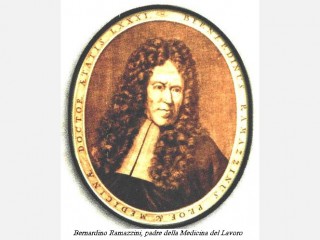
Bernardino Ramazzini biography
Date of birth : 1633-10-04
Date of death : 1714-11-05
Birthplace : Carpi, Modena, Italy
Nationality : Italian
Category : Historian personalities
Last modified : 2011-01-18
Credited as : Physicist, treatment of Malaria, wrote Diseases of Workers
The understanding of occupational diseases dates back to 1700, when the Italian physician Bernardino Ramazzini (1633-1714) wrote Diseases of Workers. As a result of these studies, he was regarded as the father of occupational medicine.
Bernardino Ramazzini was born October 4, 1633, in Carpi, Modena, Italy. Educated in philosophy and medicine, Ramazzini practiced as a physician until late in 1676, when he became a professor of medicine at the University of Modena (1682-1700) and at Padua (until 1714). In 1682 he was invited to join the university by Duke Francesco d'Esta and appointed to the chair of the theory of medicine at the university. Ramazzini took an early interest in epidemiology, the study of the causes, distribution and control of disease, and he described numerous plagues that ravaged his region of Italy. Soon he expanded his studies to occupational diseases, examining more than 50 occupations and the diseases that were frequently associated with them.
In the late 1600s Ramazzini described outbreaks of lathyrism, a disease of humans and animals caused by eating legumes of the genus Lathyrus. The disease is commonly called chick-pea poisoning and is characterized by spastic paralysis, by-paresthesia and paresthesia (a prickling skin sensation). Between 1690 and 1695 he expanded his studies to outbreaks of malaria in Italy. During this study, Ramazzini used the cinchona bark (from which the alkaloid quinine is derived) to treat his malaria-stricken patients. His use of this medicine is considered a turning point in the history of medicine. It was a practice of most physicians of the time to prescribe the cinchona bark extract for all types of illnesses; it was Ramazzini, however, who realized this medicine should not be used indiscriminately, but rather be reserved for the treatment of malaria.
Ramazzini believed in the importance of visiting workplaces and speaking directly with workers. This was not a belief shared by his peers, and he encountered much sarcasm and derision from other doctors. One of his earliest investigations found that sewage workers were affected with a severe reddening of the eyes, resulting in blindness for many of them. Ramazzini studied this phenomenon, quesa result of this study, he developed the idea for his treatise on occupational diseases.
In 1700 Ramazzini wrote De Morbis Artificum Diatriba ( Diseases of Workers. ) Although the first recorded observations of occupational disease date back to Hippocrates (c. 460-377 B.C.), De Morbis Artificum Diatriba was the first comprehensive work on occupational disease. Ramazzini applied his approach of inspecting the workplace, questioning the workers, and advising on remedies to outline the health hazards associated with chemicals, dust, metals, as well as other abrasive agents that laborers may encounter in the daily routine of their work. In his De Morbis Artificum Diatriba, Ramazzini describes over 50 dirty or dangerous trades; among those at risk, he noted, were miners, gilders, chemists, potters, tinsmiths, glassmakers, painters, tobacco workers, lime-workers, tanners, weavers, coppersmiths, and printers.
Ramazzini begins each chapter of his work with a description of the illness associated with one of the trades. Throughout the document he stresses the need to inform workers about risks to their health in the various occupations he studied. As a result of his personal approach, he was able to devote more detail to each illness and soon became the primary expert on each topic. In addition to the direct relationship between the illness and its associated occupation, Ramazzini was concerned with the pollution of the surrounding area. The expression of his concerns was perhaps the first appreciation of public-health problems.
As a result of his studies and publication, Ramazzini believed it was the responsibility of medical science to further cultivate the study of occupations and any diseases associated with them in order to provide workers with proper medical attention, thus leaving them free to pursue their trade without concern for illness overtaking them. Much of his approach to advising remedies for illnesses was based on common sense. He advised starch-makers to work in open places, and he stressed the need for improved ventilation. He recommended periodic rests from work and shorter work time to prevent eye injuries for those craftsmen employed to make very small items. He also recommended frequent interruptions to work for workers whose jobs required considerable muscular effort (bricklayers, woodworkers, and printers). Through his studies of artists who developed metallic poisoning, Ramazzini was able to determine the relationship between metals and the symptoms of metallic poisoning. He realized that the paints used by the artists were a factor in their poisoning. His interest in this area of medicine took him into the studies of diseases of other occupations such as eye conditions of printers and mercury poisoning and lung diseases associated with miners.
Ramazzini's work was soon followed by others. In 1775 Percivall Pott published a work on the diseases of chimney sweeps. Charles Turner Thackrah published an extensive study of industrial illnesses and poverty in 1831. Regardless of the proof of these various pamphlets, dissertations, and full studies, it was not until 1895 that Great
Britain became the first country to introduce statutory notification of occupational diseases.
Certainly Ramazzini can be credited with awakening the medical community to the need to protect workers from any hazards they may encounter from their occupation or their occupational environment. He can also claim credit for ensuring that health emergencies related to occupation or occupational environment are understood and dealt with in a healthy and accurate manner. Industrial medicine, factory and safety laws, and the eventual introduction of the treatment of occupational diseases into workers' compensation laws can surely be traced back to Ramazzini and his De Morbis Artificum Diatriba.
New Encyclopaedia Britannica, 15th ed., Helen Hemingway Benton, 1973-1974.
Lancet, September 4, 1999.
















